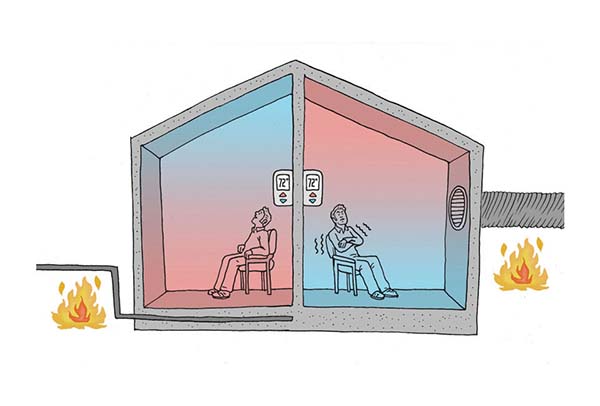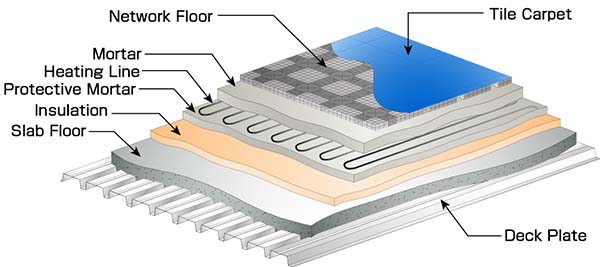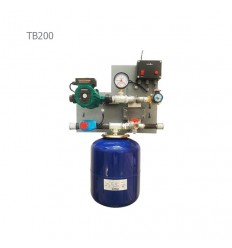- Heating Equipment Articles
- 0 likes
- 5527 views
What is an underfloor heating system?
The floor heating system is one of the newest heating systems that can be installed and implemented on the building floor. This type of heating system is developed and upgraded radiator and there are two types of floor heating with hot water and floor heating with electricity.
In the underfloor heating system with hot water, by installing five-layer pipes on the floor of the building, by the boiler (package) or the heating engine, the hot water produced by the circulator pumps flows in the pipes.
In the electric floor heating system, instead of five-layer pipes, a special heating cable is used, and the passage of electric current heats the floor of the building through the cables.

Floor heating system performance
The operation of the underfloor heating system is that with the temperature difference between the outside and the inside of the house, the thermostat of the system starts and when the heat source system is turned on, the water is heated and rises to the predetermined temperature. Then the heated water in the mixing chamber is combined with the water that has given its heat to the desired space to reach the required temperature of the space. The circulator pump moves the combined water into the pipes that are already installed under the flooring of the house. The water in these pipes transfers the heat to the floor of the house. The density of pipes or heating wires used should be chosen by the heat transfer and installation engineers based on the weather conditions of that area.
Click to view brands, models, and different types, find out the price, and buy a Circulator pump.
Types of underfloor heating systems
Underfloor heating systems are generally divided into two categories: wet systems and dry systems: in the pumps of wet heating systems, hot water is sent into the pipes under the floor, but in dry heating systems from the electric coils below. The floor of the house is used to produce the desired heating. In general, there are three types of underfloor heating systems:
- Heating with hot air: since air cannot hold heat for a long time, it will not be economical to use this method in residential environments.
- Electric current heating: A heating system with this method is economical only when the price of electric energy is low.
- Hot water heating: Hot water heating system is more economical compared to the other two methods.
Important points in the installation and operation of the underfloor heating system
- In setting up the underfloor heating system, the general design of the engine room must be done by the installation engineer.
- When starting the underfloor heating system, pay attention to the increase in the temperature of the water that enters the system; Because this increase in temperature should be such that the hot water pipes, hot water boiler, and concrete layer do not experience thermal stress.
- During piping, pay attention to the fact that the pipes do not pass over each other or under the wall.
- Green or polypropylene pipes are not a good option for underfloor heating because they leak and crack.
- Connections such as tees on the floor of the building cannot be used in the piping of the underfloor heating system.
- After the correct implementation of the underfloor heating system, the concreting stage can be implemented. For the preparation of concrete mortar, fine-grained materials should be used.
- The concrete layer should not be exposed to heavy loads for a week and should be completely dry.
- Hot water must flow separately in each circuit.
- The air valve must be installed on the return collector.
- The return collector should be placed higher than the outgoing collector because by doing this, the air in the water will go out of the system better.
- The distance between the pipes and the length of the circuits must be implemented according to the plan.
Application of underfloor heating system
This type of heating system is applicable and implemented for almost most spaces and buildings with different uses. In the following, we will mention these items:
Residential buildings, especially villas in humid areas.
To dry the ground and prevent freezing of sports places such as swimming pools, tennis courts, football, golf, etc.
It can be used in passages, ramps, airplane hangars, airport runways, roofs, etc. to dry, melt snow and ice and prevent freezing.
A floor heating system is one of the best heating methods that can be applied in poultry houses to minimize energy consumption and keep the heat at low levels. These systems reduce surface humidity and reduce animal diseases.
Floor heating systems are a suitable option to minimize the speed of heating air circulation in various industries, including the pharmaceutical and food industries. These systems are the best option for factories due to the lack of maintenance and repair costs and other benefits.
Floor heating systems can be used in places such as schools, hotels, greenhouses, museums, restaurants, cinemas, stores, historical places, and mosques.
Damatajhiz; The best prices and brands of building installation equipment
Advantages of underfloor heating system
Compared to other heating systems such as fan coils, radiators, and heaters, the floor heating system has many advantages in terms of saving energy consumption and the comfort and well-being of the building's residents. These benefits include:
- Reducing fuel consumption
- Elimination of the depreciation cost of the radiator and valve
- Creating uniform and a pleasant heat
- Freedom of action in environmental decoration
- Use of foam that is heat and sound insulation
- Comfortable heating
- Permanent dryness of the floor
- More safety and comfort
- energy saving

Disadvantages of the underfloor heating system
- Numbness and slowness in heating
- The need for an auxiliary system
- Error in execution, leakage, or freezing
The cost and price of the underfloor heating system
The price of underfloor heating depends on the type of brand of equipment and materials used in it, and it is also calculated for each square meter of equipment, design, and implementation. Setting up and running a floor heating system depends on various factors:
- Type of building use
- Type of building design and architecture
- Dimensions and useful space of the building
- Type, material, and quality of consumable equipment
- Climatic conditions of the project site
Related Articles
SAFETY TIPS FOR INSTALLING A GAS HEATER
COMPARISON OF ELECTRIC AND GAS WATER HEATERS|DAMATAJHIZ
THE VARIOUS TYPES OF JET HEATERS AND THEIR FUNCTIONALITIES

Looking forward to calling and eager to meet you in the Specialized Collection of Damatajhiz
By sharing the above article on social networks, let your friends know about its important content.





